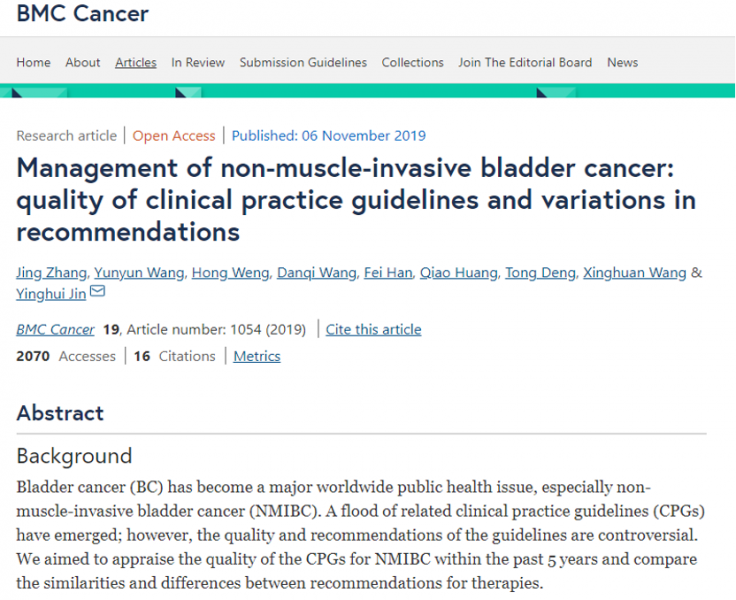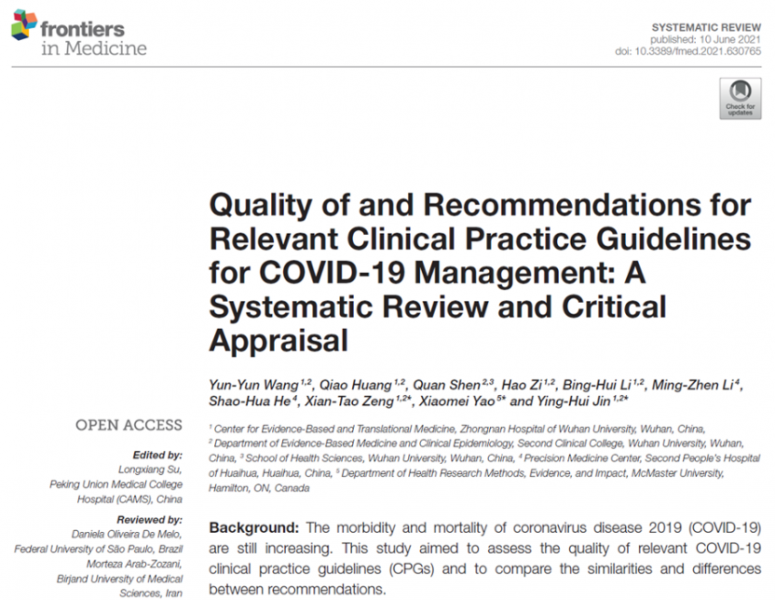1. A survey of reporting status of conflict of interest and economic evidence in Chinese clinical practice guidelines published in 2017 (in Chinese)
This study aimed to evaluate the reporting status of conflict of interest and economic evidence in Chinese clinical practice guidelines published in 2017 and to provide implications for the guideline development in China. CNKI, WanFang Data and Google Scholar were electronically searched to collect clinical practice guidelines published in 2017 from January 1st to December 31st, 2017. Two authors independently screened literature, extracted information of interest, such as conflict of interest disclosure and economic evidences, then, the analysis was performed by using the Microsoft Excel 20013 software. A total of 53 guidelines were included; in which, 14 (26.42%) disclosed conflict of interest, 10 (18.87%) stated sources of funding, and 6 (11.32%) mentioned economics evidence. In China, inadequate attention is addressed to the conflict of interest disclosure and economics evidence during the development of clinical practice guidelines. We propose the inclusion of conflict of interest and economics evidence disclosure in clinical practice guidelines, which will improve their objectivity, independence, and transparency.
This study aimed to appraise the quality of the CPGs for NMIBC within the past 5 years and compare the similarities and differences between recommendations for therapies. A systematic search to identify CPGs for NMIBC was performed using electronic databases (including PubMed, Embase, Web of Science), guideline development organizations, and professional societies from January 12, 2014 to January 12, 2019. The Appraisal of Guidelines Research & Evaluation (AGREE) II instrument was used to evaluate the quality of the guidelines. Intraclass correlation coefficient (ICC) analysis was performed to assess the overall agreement among reviewers. Nine CPGs were included. The overall agreement among reviewers was excellent. The interquartile range (IQR) of scores for each domain were as follows: scope and purpose 69.44% (35.42, 85.42%); stakeholder involvement 41.67% (30.56, 75.00%); rigour of development 48.96% (27.08, 65.63%); clarity and presentation 80.56% (75.00, 86.11%); applicability 34.38% (22.92, 40.63%) and editorial independence 70.83% (35.42, 85.42%). The NICE, AUA, EAU and CRHA/CPAM clinical practice guidelines consistently scored well in most domains. It was generally accepted that the transurethral resection of bladder tumour (TURBT) and intravesical chemotherapy should be performed in the management of bladder cancer. The application of chemotherapy was highly controversial in high risk NMIBC. The courses of BCG maintenance were similar and included 3 years of therapy at full maintenance doses. The quality of NMIBC guidelines within the past 5 years varied, especially regarding stakeholders, rigour and applicability. Despite many similarities, the recommendations had some inconsistencies in the details.
This study aimed to assess the quality of relevant COVID-19 clinical practice guidelines (CPGs) and to compare the similarities and differences between recommendations. A comprehensive search was conducted using electronic databases (PubMed, Embase, and Web of Science) and representative guidelines repositories from December 1, 2019, to August 11, 2020 (updated to April 5, 2021), to obtain eligible CPGs. The Appraisal of Guidelines for Research and Evaluation (AGREE II) tool was used to evaluate the quality of CPGs. Four authors extracted relevant information and completed data extraction forms. All data were analyzed using R version 3.6.0 software. In total, 39 CPGs were identified and the quality was not encouragingly high. The median score (interquartile range, IQR) of every domain from AGREE II for evidence-based CPGs (EB-CPGs) versus (vs.) consensus-based CPG (CB-CPGs) was 81.94% (75.00–84.72) vs. 58.33% (52.78–68.06) in scope and purpose, 59.72% (38.89–75.00) vs. 36.11% (33.33–36.11) in stakeholder involvement, 64.58% (32.29–71.88) vs. 22.92% (16.67–26.56) in rigor of development, 75.00% (52.78–86.81) vs. 52.78% (50.00–63.89) in clarity of presentation, 40.63% (22.40–62.50) vs. 20.83% (13.54–25.00) in applicability, and 58.33% (50.00–100.00) vs. 50.00% (50.00–77.08) in editorial independence, respectively. The methodological quality of EB-CPGs were significantly superior to the CB-CPGs in the majority of domains (P < 0.05). There was no agreement on diagnosis criteria of COVID-19. But a few guidelines show Remdesivir may be beneficial for the patients, hydroxychloroquine +/– azithromycin may not, and there were more consistent suggestions regarding discharge management. For instance, after discharge, isolation management and health status monitoring may be continued. In general, the methodological quality of EB-CPGs is greater than CBCPGs. However, it is still required to be further improved.
Implementation of quality improvement projects based on N-CPGs has becoming an hot topic for nursing with proliferation in the number of N-CPGs in China in recent years. The methodology for developing N-CPGs is worthy of exploration. A systematic literature search was performed using PubMed, CINAHL, Web of Science, CNKI, WanFang, VIP and CBM and relevant representative guidelines repositories from inception to July 31, 2019. Two authors independently selected eligible guidelines and performed data extraction. Four appraisers independently assessed the quality of the N-CPGs using the AGREE II tool. 20 N-CPGs were eventually included in this review. After AGREE II appraisal, the final domain scores ranged between 0.00 and 83.33%. When comparing the total domain scores, “Scope and purpose” and “Clarity of presentation” scored highest with a total of 63.89 (59.37–69.79) (%, median, interquartile range (IQR)), and 63.89 (58.33–75.70) (%), respectively. “Editorial independence” obtained the lowest ranking with a total score of 0 (0–81.25) (%). The total scores of “Stakeholder involvement”, “Rigour of development”, “applicability” and “editorial independence” were lower than 50%. The quality of N-CPGs in China is not very high and the process of guideline development still needs to improve.
This study aimed to systematically evaluate the quality of clinical practice guidelines (CPG) for medically treating benign prostatic hyperplasia (BPH), and to compare the context of recommendations in order to provide references for clinical application. We searched databases of National Guideline Clearinghouse (NGC), Guidelines International Network (GIN), National Institute for Health and Clinical Excellence (NICE), Scottish Intercollegiate Guidelines Network (SIGN) and World Health Organization (WHO), PubMed, Embase, CNKI, VIP, WanFang Data, CBM, and Medlive from their establishment to October 13, 2019, to collect evidence-based guidelines and/or consensus on BPH. Method quality of included guidelines was assessed according to the Appraisal of Guidelines for Research and Evaluation II (AGREE II) instrument, and differences and similarities among recommendations were compared. A total of 22 guidelines were included, of which eight were updated versions. According to the AGREE II instrument, the median score of scope and purpose, stakeholder involvement, rigor of formulate, clarity of presentation, applicability, and editorial independence was 71.5%, 41%, 25%, 64%, 18%, and 28%, respectively. Based on recommendations for medical treatment, almost all guidelines recommended a1-blockers and 5a-reductase inhibitors, and most guidelines also recommended muscarinic receptor antagonists. In terms of drug combination therapy, most guidelines recommended “a1 blockers and 5a-reductase inhibitors”, and some guidelines also recommended “a1-blockers and muscarinic receptor antagonists”. The recommendations from different guidelines were basically similar, only showing conflicts in some areas. The quality of included guidelines remains to be unified, and their context can provide valuable implications for development or improvement.
6. Quality assessment of clinical practice guidelines for benign prostatic hyperplasia (in Chinese)
This study aimed to evaluate the methodological quality of published clinical practice guidelines for benign prostatic hyperplasia. PubMed, EMbase, CNKI, WanFang Data, VIP and CBM databases, website of Yimaitong, and international authoritative guide platforms were electronically searched to collect the relevant clinical practice guidelines or consensus for benign prostate hyperplasia. The retrieval covered the time up to December 13th, 2016. Literatures were independently screened by 2 reviewers. After data extraction, the methodological quality of included guidelines was evaluated by 4 reviewers using the AGREE Ⅱ. Each domain score was calculated and the intraclass correlation coefficient was used to evaluate the consistency among the reviewers. A total of 15 clinical practice guidelines were included. The mean scores for the six domains in AGREE Ⅱ were: 72%, 38%, 30%, 58%, 16%, and 40%, respectively. The intraclass correlation coefficient was larger than 0.87, which indicated the total consistency was well. The quality of clinical practice guidelines for benign prostatic hyperplasia is not satisfactory as expected. They are heterogeneous in quality and some requires improvement. Guidelines are required to be further developed in methodology in future, especially in three domains, including participants, preciseness and applicability of the design.
7. Quality evaluation of nursing clinical practice guidelines in China (in Chinese)
This study aimed to evaluate the quality of clinical nursing practice guidelines in China. Two researchers searched domestic and foreign databases, including PubMed, CINAHL, Web of Science, CNKI, China Biomedical Abstracts Database (CBM), Wanfang Database, VIP Chinese Sci-tech Journals Database (VIP) and related websites from inception until July 31, 2019. The quality of the included guidelines was evaluated by using the evaluation tool for Chinese clinical
practice guidelines (AGREE-China), the RIGHT list and the implementation evaluation tool for guidelines (GLIA 2.0). A total of 20 guidelines were included. The average score of AGREE-China was 71.71 ±13.16. The overall reporting rates of the RIGHT list were between 0 and 100.0%. In the results of implementation evaluation, the highest coincidence rate of a single guideline was 100.0%, and the lowest was 60.0%. The overall quality of Chinese nursing clinical practice guidelines is good, but there are few reports on effectiveness/safety, autonomy and types of conflict of interest.


